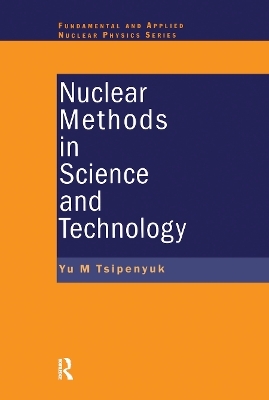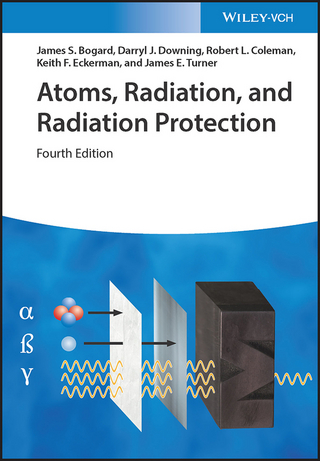
Nuclear Methods in Science and Technology
Seiten
2019
CRC Press (Verlag)
978-0-367-45588-0 (ISBN)
CRC Press (Verlag)
978-0-367-45588-0 (ISBN)
This book covers the major points of basic theory and experimental methods of nuclear physics, emphasizing the behavior of real systems. Using many examples, it also illustrates the extraordinary possibilities offered by nuclear methods. The book covers the Mossbauer effect, slow neutron physics, radiography, nuclear geochronology, and various othe
The application of nuclear physics methods is now widespread throughout physics, chemistry, metallurgy, biology, clinical medicine, geology, and archaeology. Accelerators, reactors, and various instruments that have developed together with nuclear physics have often been found to offer the basis for increasingly productive and more sensitive analytical techniques.
Nuclear Methods in Science and Technology provides scientists and engineers with a clear understanding of the basic principles of nuclear methods and their potential for applications in a wide range of disciplines.
The first part of the book covers the major points of basic theory and experimental methods of nuclear physics, emphasizing concepts and simple models that give a feel for the behavior of real systems. Using many examples, the second part illustrates the extraordinary possibilities offered by nuclear methods. It covers the Mossbauer effect, slow neutron physics, activation analysis, radiography, nuclear geochronology, channeling effects, nuclear microprobe, and numerous other topics in modern applied nuclear physics. The book explores applications such as tomography, the use of short-lived isotopes in clinical diagnoses, and nuclear physics in ecology and agriculture. Where alternative nonnuclear analytical techniques are available, the author compares the relevant nuclear method, enabling readers to judge which technique may be most useful for them.
Complete with a bibliography and extensive reference list for readers who want to delve deeper into a particular topic, this book applies various methods of nuclear physics to a wide range of disciplines.
The application of nuclear physics methods is now widespread throughout physics, chemistry, metallurgy, biology, clinical medicine, geology, and archaeology. Accelerators, reactors, and various instruments that have developed together with nuclear physics have often been found to offer the basis for increasingly productive and more sensitive analytical techniques.
Nuclear Methods in Science and Technology provides scientists and engineers with a clear understanding of the basic principles of nuclear methods and their potential for applications in a wide range of disciplines.
The first part of the book covers the major points of basic theory and experimental methods of nuclear physics, emphasizing concepts and simple models that give a feel for the behavior of real systems. Using many examples, the second part illustrates the extraordinary possibilities offered by nuclear methods. It covers the Mossbauer effect, slow neutron physics, activation analysis, radiography, nuclear geochronology, channeling effects, nuclear microprobe, and numerous other topics in modern applied nuclear physics. The book explores applications such as tomography, the use of short-lived isotopes in clinical diagnoses, and nuclear physics in ecology and agriculture. Where alternative nonnuclear analytical techniques are available, the author compares the relevant nuclear method, enabling readers to judge which technique may be most useful for them.
Complete with a bibliography and extensive reference list for readers who want to delve deeper into a particular topic, this book applies various methods of nuclear physics to a wide range of disciplines.
P L Kapitza Institute for Physical Problems, Russian Academy of Sciences, Moscow, University of Malaya, Kuala Lumpur
Nuclear structure. Natural and artificial radioactivity. Nuclear reactions. Uniformities in the passage of nuclear particles through matter. Detectors of nuclear radiation. Slow neutron physics. Nuclear methods for analysis of substance structure and composition. Nuclear imaging. Mossbauer effect. Nuclear physics, geology and archaeology. Radiation effects. Practical applications of heavy ion and muon beams. Bibliography. References. Index.
| Erscheinungsdatum | 29.11.2019 |
|---|---|
| Reihe/Serie | Series in Fundamental and Applied Nuclear Physics |
| Verlagsort | London |
| Sprache | englisch |
| Maße | 156 x 234 mm |
| Gewicht | 453 g |
| Themenwelt | Naturwissenschaften ► Physik / Astronomie ► Angewandte Physik |
| Naturwissenschaften ► Physik / Astronomie ► Atom- / Kern- / Molekularphysik | |
| ISBN-10 | 0-367-45588-9 / 0367455889 |
| ISBN-13 | 978-0-367-45588-0 / 9780367455880 |
| Zustand | Neuware |
| Haben Sie eine Frage zum Produkt? |
Mehr entdecken
aus dem Bereich
aus dem Bereich


